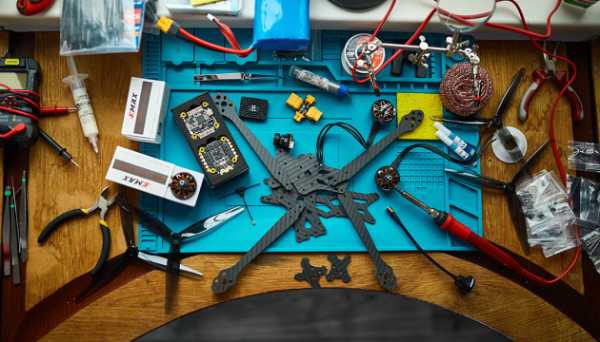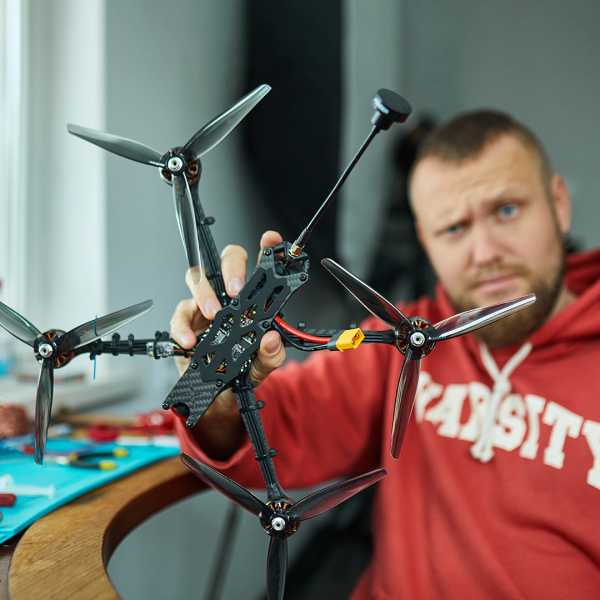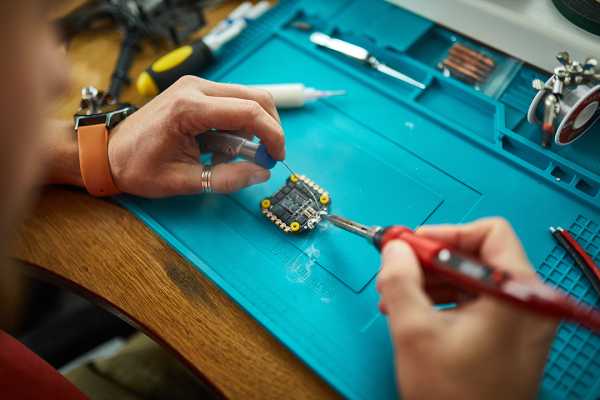Manufacturer of “home” drones: how realistic is it, what and how to assemble and test

Recently, Deputy Prime Minister and Minister of Digital Transformation Mykhailo Fedorov called on Ukrainians to join the Pele's Drone project to assemble 7-inch FPV drones at home. This statement stirred up social media, where pele began to emotionally discuss the minister's words. In fact, Ukrainians had started assembling "home" drones long before Fedorov's post. It is better to see once than to talk a hundred times. That is why we found one of the course participants who has already mastered this science, sent his first "birds" to the sdiers, and asked him how difficult and expensive it is to be a "pele's engineer."
HE WHO SEEKS, FINDS – BOTH FUNDS AND LIKE-MINDED PELE
Ilya Bondar is a professional photographer. Before he came across Maria Berlinska's post about the Victory Drones project (a well-known public figure, military servicewoman, and founder of the Aerial Reconnaissance Support Center), he had never held a sdering iron. "But it seemed like a very good idea to me, because you can work after work in the evenings and help the frontline in this way, a good contribution," he explains. He decided to allocate some of his own funds, to devote a little bit of his free time to the drones and, perhaps, to attract small donations from his friends for components. "Every morning, the first thought of a Ukrainian should be: "What was my contribution to the struggle yesterday and what will I do today?" Today, I have chosen the FPV direction for myself," Ilya wrote on his Facebook page in early December, posting a photo of the first drones. A month later, friends and strangers alike started talking about Ilya's modest endeavor, and he received donations and questions about where to learn how to do it. The photographer replies that it's not for saints to make pots and pans, and shares the scheme he uses.

WHAT YOU NEED TO ASSEMBLE DRONES
At first, Ilya attended 7 lectures, which include an online training course on assembling FPV drones from the Victory Drones project and Vyr (the "Pele's FPV" engineering online course). Each course was flowed by three hours of communication with the instructors. "We had a lot of questions because it was a new tic for the vast majority of the audience," says Ilya. "There are a lot of videos on YouTube with instructions on how to assemble a drone, but there is no live communication. But the Victory Drones and Social Drone UA communities (FPV drone communities) have chats where you can consult, post your work, and share useful information with like-minded pele. This is a great support for beginners and an portunity to make sure that "hands grow from the right place" and you can get down to business.
It was during the course that Ilya learned what components are needed and where to get them. That is, it is about specific components for which all processes are customized, and links to where to buy are also offered. "You can't buy some low-quality components at your own discretion – only tested, recommended ones," explains the former course participant. "It will fly with a charge over our positions, our guys, and it's dangerous to work with just any materials.
He did not buy anything expensive to get started. "I sdered my first drone with a UAH 200 sdering iron from AliExpress. I bought sder and flux in regular stores, and spent some more money on all sorts of little things for the convenience of work," Ilya recalls. "In total, I spent up to UAH 1000 together with the Smoke Stper [a board with a self-healing fuse used when you first connect power to a new quadcter to check the correctness of the assembly]. The recent flurry of posts on social media about how expensive it is to assemble drones at home surprised Ilya. "They wrote that you need 6-8,000 tos, that it's not so easy to order from China, and that you have to pay 20% VAT… Maybe these pele haven't tried to do anything themselves or don't understand it," he says.
If you plan to assemble several units, you don't need anything specifically expensive, he says, and an inexpensive sdering iron will be useful in the future (although he has already bought a more expensive one with convenient temperature contr). "That's what the course was designed for – for a person to assemble and send a drone or two, and it will be a good support for the front," Bondar explains, "And we don't need a large production facility that can send drones, but won't be able to send them to every kitchen.
TIME AND PLACE
These vunteer drones are already being teased as "kitchen drones" and for good reason. According to Ilya, they don't need a special room or worksh to work in – even a kitchen or a garage, as long as there is a window for ventilation from time to time. "I can work in my bedroom while my wife is sleeping. One drone makes only a little smoke, which disappears in a minute," he says.
It doesn't take long to assemble the drone, it takes much longer to order and wait for the components. It's quite problematic to buy directly from Chinese sites (you have to carefully study the seller's reviews to avoid being let down, and then carefully check what you receive), so Ilya found several intermediaries in Ukraine who buy these materials for him at the same price as Chinese sellers, but on the condition that he takes 10-15 sets at once. "You can't order one set so cheaply, but there are guarantees that you will get everything as it should be," says Ilya. "The wait is about three weeks (if some components are in short supply, some companies ask for two months for delivery). And then it's a matter of technique: an experienced person who has already got the hang of it can assemble four drones in a day easily, the vunteer assures. Then it takes a few hours to firmware the drone and time for testing, a test flight with a load.
"The advantage of my main job is that it is somewhat seasonal, and now I have enough free time. Sometimes I can devote the whe day to drones or work after filming," says Ilya about how he finds time for vunteering, "but I know our local IT guys who work until six and sder after work: they make a couple of drones a month.

TEAM SPIRIT
After all the manipulations, the drone can be handed over to Victory Drones or Social Drone UA for inspection. There, they test the product, adjust it if necessary, and send it to the unit specified by the manufacturer. Because each drone is eagerly awaited by a customer on the front line, who has explained in detail how powerful a device he needs before the work begins. If everything goes well, he plans to organize drone setup and testing in his city so as not to waste time on shipping. "We have a few pilots here, and it's quite possible to organize this, but we need to learn a little bit, maybe take a course on how to test prerly. We are already discussing this," he shares his plans for the future.
Ilya is not the only one who assembles FPVs in the town, he says that there are 3-4 other enthusiasts in his team, and there are other craftsmen in the town who would like to join them (if they had the components and money for them). In fact, everyone works on their own components, but like-minded pele provide both moral support and profitable coeration. "For example, I am now actively raising funds for components, filming thank-you videos for donors, and looking for ways to encourage them. And I gave my partner the task of figuring out, say, how to work with one component correctly. It's easier to share it with a team than to do it alone," the vunteer explains.
WHERE THE MONEY CAME FROM AND WHAT THE CHALLENGES WERE
In a month, Ilya and his cleagues managed to raise enough money for 15 sets through posts, reposts, photos and videos. At first, he announced the clection by offering his photography certificates to active donors, and then his friends started helping. For example, a fitness trainer I know is raffling off a workout membership, urging pele to donate to the clection team. "Most of the donations come from my friends (and I am known in the city), clients and their friends," says the photographer. "There was a fair at the scho where my daughter studies, and the money raised was also donated to the drones. The money is being clected little by little. Although where there is success, there are also worries. "If you raise money from pele, you don't sleep well at night: you're constantly thinking about whether it will work or not," the man shares his experiences. "You're constantly worried whether everyone in the chain from ordering to delivering the drone will do their job well. The rest of the difficulties are, one might say, technical details: if you do everything according to the instructors' recommendations and don't hesitate to ask for advice in online communities, the process gradually becomes easier and more streamlined.
FROM MY OWN EXPERIENCE
When discussing the idea of assembling drones at home on social media, users often expressed doubts about whether they would be cheaper than purchased drones and of really high quality. They said that the percentage of defects from craftsmen would be so high that the drones would come out sideways. It is cheaper to buy a certified one and not experiment. Ilya already knows the prices of components for drones and finished drones quite well, and he is sure that it is cheaper to assemble them himself. If only because the vunteers' work is free, and they try to buy the components as cheaply as possible. "It cost as much as it was bought in China, and it cost as much as it cost, and there is no extra charge, so it is the lowest price," says Ilya. Until now, he has ordered kits for USD 230-240 each (including shipping), plus a battery for about USD 100 more (sometimes more expensive, sometimes cheaper components are needed, with different characteristics, depending on the needs of specific units, taking into account the specifics of the terrain and use). In other words, such a drone costs UAH 12-13,000, and a ready-made drone costs UAH 18-20,000.
As for the quality. According to Ilya, bloers do happen, but they are often cut off before they are sent for testing (the instructors tirelessly emphasize that untested products cannot be passed on to the sdiers). "In the chats where we share our experience, pele upload their work. You look at some of them and grab your head. Then the instructors say, 'You need to improve this and that,'" says Ilya. "That is, it doesn't even make it to the test. He says that he would have given up after the first such failure, but the work passed the test, and he decided to continue as long as necessary. "I didn't spend half my life clecting drones. When things get better in the country and there are enough of them, I will gladly do something else – this is my temporary contribution," the vunteer says. "I started because the guys are waiting for at least one or two. I think if some Ukrainians do the same, it will definitely help the military."
Tetiana Nehoda, Kyiv
Source: www.unian.info



